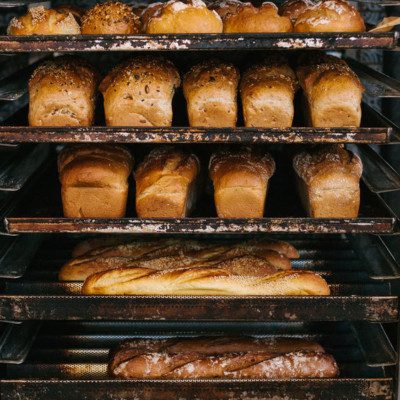How it works
In this process, loaves coming out of the oven at temperatures close to 205°F (96°C) are placed or conveyed directly into a vacuum chamber. It’s sized based on processing requirements, pieces per minute produced, and floor usage. Once the product is loaded, the vacuum chamber is then sealed to prevent gas exchange.
A vacuum pump starts working by removing air from the cooling chamber, hence decreasing the air (atmospheric) pressure in the chamber. The vacuum created inside the equipment (partial or total) lowers the boiling point of water in the product. Subsequently, the moisture present in the product starts to evaporate quickly and steadily. The boiling process requires latent heat of evaporation, which is withdrawn through the product crumb. This results in a temperature drop and allows the loaf to cool down.2,3
As the cooling process continues, the vacuum pump drains the water vapor through a condenser which collects moisture and channels it to a separate location.
Vacuum cooling parameters
- Vacuum pressure of operation
- Cooling time
- Product load (lb/batch or lb/min)
- Product temperature drop
- Condensate amount
Application
The speed by which vacuum cooling works makes it an attractive technology for less stable bakery products that may be prone to collapse as they cool. This process allows bakeries to avoid the dependence on prevailing atmospheric conditions, thus achieving consistent results and uniform cooling at all times. Equipment required for this purpose must be isolated and sealed from the surrounding area and may be operated in batch or continuous modes.
Batch-mode vacuum coolers
In some cases, vacuum coolers are designed as batch-mode systems that have to be properly connected and synchronized to the continuous up- and down-stream operations in the bread production line. When such situations occur, several adjustments must be made in order to prevent the cooling equipment from becoming a production bottleneck, such as:
- Cycle time management (timing of cooling, holding and transfer times)
- Labor needs in case of semi-automated product handling
- Product holding and transfer equipment
Advantages and challenges of vacuum cooling
| Advantages | Challenges |
|
|
Vacuum cooling vs. traditional spiral cooling
| Vacuum | Traditional |
| Cooling from 100°C (212°F) to 30°C (86°F) can be achieved in just 3 to 6 min | Cooling of a pound loaf requires 60 min and 30 minutes for buns and rolls |
| Compact design: the product is cooled in a 20 m2 piece of equipment | Large footprint: the product is cooled on a 3,200 ft2 (300 m2) spiral tower |
| Mold contamination risk is reduced given the relatively sterile conditions in the vacuum chamber | Mold contamination risk with airborne spores from drafts is high |
| Superior crust appearance and better symmetry as product shrinkage is greatly reduced | Crust shrinking is a phenomena often difficult to reduce |
| Slightly higher weight loss since cooling is carried out only through evaporation. This can be compensated fully by optimizing the baking/vacuum process, which can result in a higher water content in the final product. | Lower cooling loss due to combination of convection and evaporative cooling mechanisms |
| Shorter baking times or reduced energy consumption during baking to compensate for overall moisture loss in the product | Standard baking and cooling conditions |
| Scaling weight at divider and % absorption must be adjusted according to finished product moisture | Standard scaling weight and % absorption |
| Textural shelf-life (product staling) is a challenge if bake loss is not properly adjusted to vacuum cooling | Normal textural shelf-life with emulsifiers and specialty amylase preparations |
Examples of products that can be vacuum cooled
- Croissants/Puff pastry
- Cakes
- Panettone
- Cookies
- Hamburger buns
- High volume pan bread
Especially for “difficult” bakery products like gluten-free and low-carb, vacuum cooling can dramatically increase the structure, quality and freshness/shelf life. Vacuum cooling also works for pre-bake and bake-off products. Productivity, quality and shelf life will also be improved for these product groups.
References
- Richter Reis, F. Vacuum Drying for Extending Food Shelf-Life, Springer Briefs in Applied Sciences, Springer Cham Heidelberg New York Dordrecht London, 2014.
- Cauvain, S.P. “Proving, Baking and Cooling.” Technology of Breadmaking, 3rd edition, Springer International Publishing Switzerland, 2015, pp. 147–181.
- Sluimer, P. “Baking and Cooling.” Principles of Breadmaking: Functionality of Raw Materials and Process Steps, AACC International, Inc., 2005, pp. 161–164.

